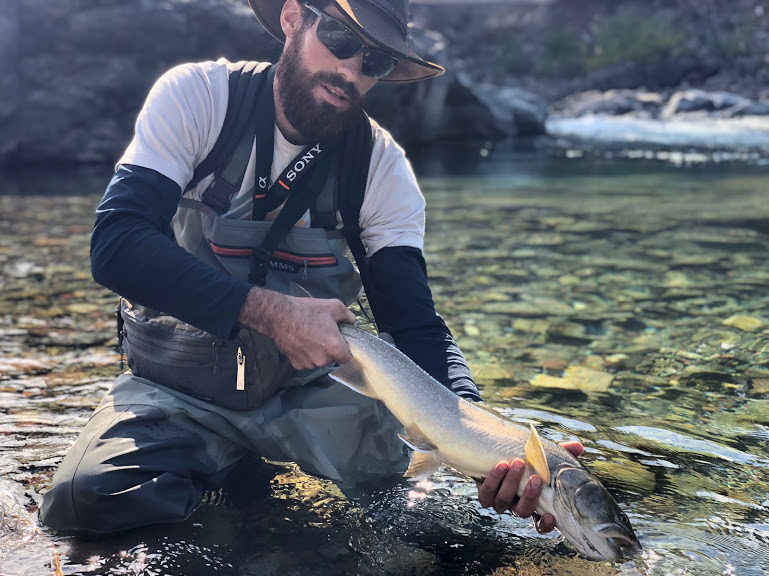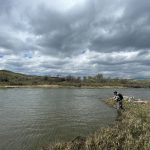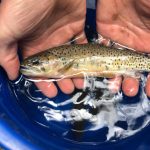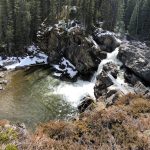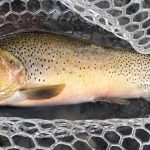Pt. 2: Threats facing Bull Trout
The reason for Bull Trout populations decreasing across the province can be broken down to 3 main things, according to the SRD Report.
- 1) Climate Change leading to more seasonal variation,
- 2) Human Land use leading to environmental degradation, and
- 3) Fishing Pressure and Fish Harvesting.
These are the 3 main factors that effect all our Fish species, however, Bull Trout are the most susceptible to each of these threats than other fish. Why?
First, unlike Rainbows, Browns, and some other fish that can live in a broader range of conditions and water temps, Bull Trout absolutely need cold, clean water. This means they are more susceptible to things like droughts, low snowpack years, and extreme heat, AKA climate variability, which as we know becomes more of a problem as we deal with the effects of Climate change in the future. The past several years in Alberta have come with droughts, extreme heat, and low water flows. These conditions can have very serious effects on Bull Trout, especially when coupled with angling pressure.
Human interference through Forestry, Oil and Gas Development, and farming also affect their habitat by increasing flow rates in the spring (more run-off in spring from farms, clear cuts, roads), which will degrade in stream habitat (less pools, log jams, undercut banks where trout live, more flat boring water without shelter from predators), compromise spawning grounds (silt bottoms from forestry run-off instead of gravel bottoms), and will also lead to lower stream flows in the summer and fall (a natural forest serves to collect and slowly distrubute water throughout the season, a process that is compromised by the above land uses), which will mean warmer in stream temps this time of year. All of these environmental factors have the potential to negatively impact Bull Trout.
Fish harvesting is very detrimental to Bull Trout because Bull Trout take a very long time to reach spawning maturity (usually at least 5 years). This means a Bull Trout has a much higher chance of being harvested before it can spawn, compared to something like a Brook Trout, which can reach spawning maturity in as little as one year. That is why Brook Trout reproduce so quickly, and can withstand fish harvesting.
This leads into the final threat facing Bull Trout, which is invasive fish species. Invasive fish species, like the Brook Trout, but also Brown Trout and Rainbow Trout in Alberta, reproduce faster and out-compete/over populate native fish, which means there are cases of streams that used to contain Bull Trout that now only have Brook Trout or Brown trout.
It is important to understand that is is a combination of the above threats leading to the diminishing Bull Trout population, and the threat may be different in each water shed and for each population/ sub-population. Fishing pressure and harvesting is the one threat that we as anglers have the ability to control, therefore it is critically important we do so so we don’t compound the issues created by the other two threats.
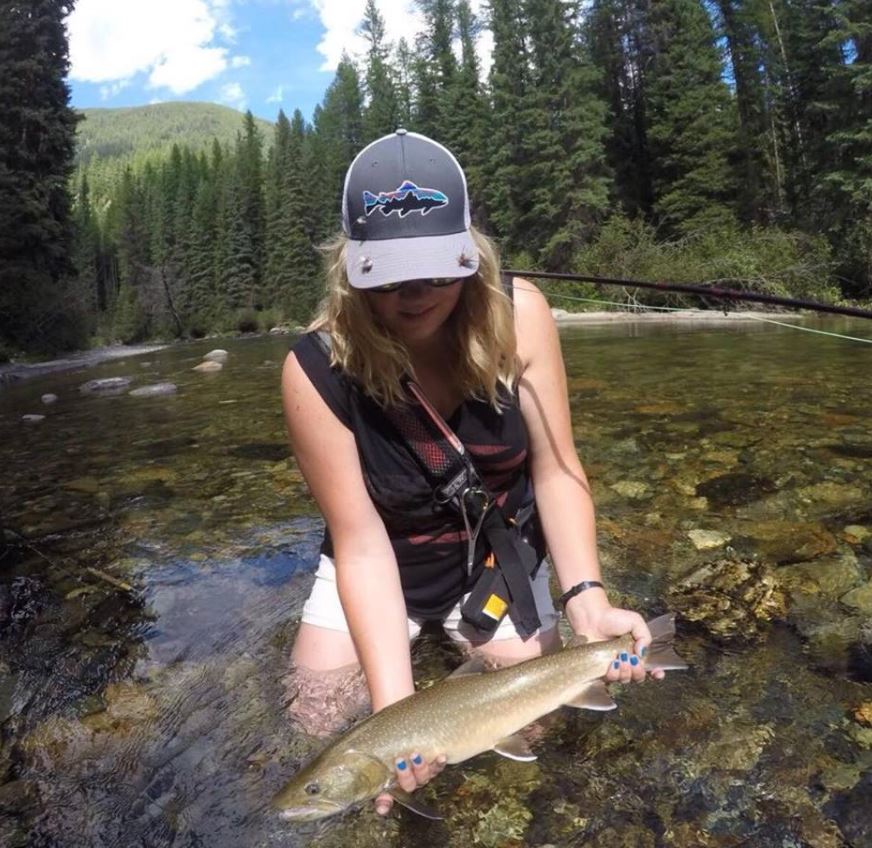
So, time to hit you with the Numbers… How threatened are Bull Trout?
This is the part where all the scary statistics come into play. Remember, this data is from 2005… What do you think these stats would be now, 13 years later?
Fisheries Managment Biologists have separated Alberta’s Bull Trout Populations into 51 Core Populations, made up of 128 subpopulations (genetically distinct stocks). Out of these 51 Core populations,
- 78% are ranked as either ‘High Risk’ or ‘At Risk’
- 16% are ranked as ‘Potential Risk’
- 6% are extirpated (no longer present)
- 0% are Rated as ‘Low Risk’
- 61% of Core populations are in a state of decline
- 39% of Core Populations are stable or in a state of population increase
- However, many of these 39% are still rated as ‘High Risk’ or ‘At Risk
- Bull Trout Occupy less than 66 % of their native range
The good news is that 66% of core populations were rated as having a ‘Moderate’ to ‘High’ potential for recovery.
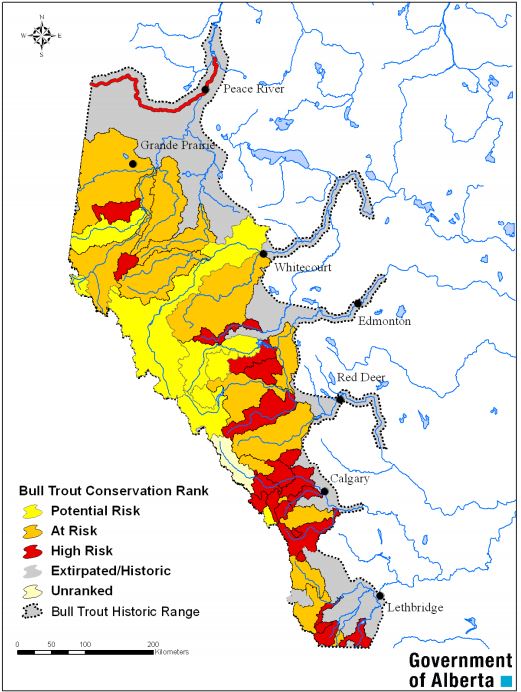
Some may find these numbers alarming. Others may find them underwhelming, something to not be concerned about. Knowing that most of the streams have the potential to recover is encouraging, however, knowing that 78 % are still at risk means we are very, very far from solving the problem. Bull Trout became catch and release in Alberta in 1994, meaning after 10 years of catch and release regulations 61 % of populations were still in decline. However, the 39 % that stabilized or increased largely did so because of C & R regulations, proving that C & R does work and is very important.
The SRD report goes on to break down each Core population into population type, population size, population range, the risk rating, the severity of threats, and the population trend. All very interesting stuff if you’re like me and want to know exactly how many fish are in all your Favourite streams.
I am not going to share all of that, as your brains might explode, but I will share a few of the core populations, especially those in the popular Bull Trout streams of southern Alberta so that you can see how each is doing. If you want to see every population, check out the SRD report (pg. 26-29).
Note* Not all Core Populations within Watershed are listed. I have compiled a few examples from each watershed. The total amount of core populations is listed beside the Watershed name, eg. Oldman (10) , meaning there are 10 total core populations in this drainage. Full charts available from SRD Report.
Oldman Basin

As you can see, the Upper Oldman and the Upper Livingstone are both listed as ‘Stable’ and have moderate chances of recovery. On the other hand, the Lower Oldman River, Waterton River, Drywood creek, with low chances or recovery, while Willow Creek no longer has a population. This can be strongly attributed to the Oldman Resevoir Dam, which has disconnected the populations below the dam from the more stable populations above the Dam.
As is a theme, Resident populations in Small Creeks are all very close to Extirpation, as has already happened in Willow Creek. This is true across all watersheds in Alberta.
There is additional info available on the Upper Oldman River Area from a 2009 study, available here Bull Trout Population Assessment in the Upper Oldman River Drainage, 2009 which breaks down each tributary/ potential spawning ground. It concludes that Hidden Creek is a critical spawning ground for Migratory populations of Bull Trout in the Upper Oldman.
Bow River Basin

A few things jump out at me from this one. First, the extremely low population numbers in the Highwood River. Remember, this is data from 2004. To think that there is, or mind you, WAS,only a maximum of 750 mature Bulls in that entire river system is astounding, considering the amount of fish it seems like there is. It is not unlikely that populations may have significantly rebounded in the past 14 years, and population numbers may be closer to the Populations in the Sheep River. Cause boy, it sure feels like there is more than 750 Bulls in there.
Again, Flat Creek, Jumpingpound Creek, Canyon Creek (not listed), are all small creeks with Resident populations in critical shape.
Red Deer River Basin

Now, I find this graphic the most interesting, for a few reasons. The first being that I have spent almost everyday single day this summer fishing the Red Deer River highcountry, so it’s personal. Secondly, I find it very intriguing that there are only 2 total Core populations in the whole basin, one of them close to extirpation (if not already extirpated within the last 14 years) However, again, the trend of smaller streams with a critically low population of resident Bulls is present.
In Lorne Fitch’s ‘Two Fish. One Fish, No Fish,‘ there is a part that says “In many watersheds, populations of Bull Trout may have disappeared before we even knew they were in there.”
I think this is the situation in the Red Deer River system. The waters of the Upper Red Deer River are beautiful Bull Trout waters. An angler peering into the pools of the upper James River would be sure there would be Bulls in every one of the plentiful pools, if he didn’t know any better. However, I’ve never caught a Bull up there. And the locals tell me there isnt any fish at all in the Upper James. Why would there be no Resident populations in rivers like the James, or the Panther, the Dormer, or any of the many other small creeks? I find it hard to believe that there was never resident populations. No, I believe these populations were essentially extirpated by the time we started monitoring.
The Red Deer River Basin is a good example of the cumulative effects of all the threats listed above. The area has a long history of land use and land exploitation. The Coal Camp road which gives access to the waters of the Upper Red Deer was developed to allow industry into the area. All the way up to the Banff National park border, there is extensive forestry, Oil and Gas development, Cattle Ranching, and heavy recreational use with ATV’s and dirtbikes. It was, and still is, a prominent area for hunting, outfitting and trapping, all activities which brought with them people and fishing pressure. Without a doubt, the Upper Waters of the Red Deer are a shade of what they once were, and fish harvesting was a major contributor. I stumbled upon an excerpt from the book People and Peaks of the Panther River and Eastern Slopes, that really sheds light on this. It is taken from a one-on-one interview from an old-time outfitter in the area.
“I remember fishing for Dolly Varden trout, which was something… You could catch bagfuls of them. Most were two-and-a-half to three pounds. They’d spawn and would go up the Little Red and Harrow Creek.
The Stoney indians used to come from Morley with a team and wagon. They would follow these (spawning) fish coming up the river. They smoked the fish- hundreds of them; but the fish disappeared. All of a sudden, after the war there were no more Dolly Varden Trout. They just disappeared.”
– Jim Hole, from 2008 interview in People and Peaks of the Panther River and Eastern Slopes (pg. 305)
Bagfuls of spawning Bull Trout! That left me shaking my head. It’s amazing the extent of the damage done by old timers. This is just one of several stories from this book relating to over-fishing. If someone were to take 100 Bulls from a spawning ground these days, they could be taking 40-50 % of the total population. And back then, it was considered the norm. No wonder they disappeared.
However, I believe if more research was done it would be found that there are resident populations still hanging on in the Panther River and other tributaries. Why do I say this? Well, there is a pool, one among many within 15 minutes of walking from the Lodge at Panther River, that caught my interest. In this pool was an unmistakable huge Bull Trout, one of the largest I’ve ever seen. He had much more color than the average Bull in the Panther; more olive and orange compared to the usual silver chrome. This Bull Trout was there in late April. He was there in early July, after run-off ended.. He was there in September, when I saw him eat a grasshopper off the surface; only to sink to the bottom the second I made my first cast. He was there in October during the Bull Trout Spawn. While many of the smaller, 16″-22″ Bulls seemed to disappear and move around as the season moved on, this Bull Trout was always in the same spot. If part of a fluvial Red Deer River population, wouldn’t this unmistakable Bull be on the move, at some point in the season? Who knows. All I know is that in the past, before we came, and exploited, there was probably a Bull like him in each and every pool. Now, they are few, and far between.
Click here to continue reading part 3, What you can do as an Angler.
Resources:
2012-2018 Bull Trout Conservation Management Plan
Bull Trout Population Assessment in the Upper Oldman River Drainage, 2009
Two Fish, One Fish, No Fish: Alberta’s Fish Crisis – Lorne Fitch

